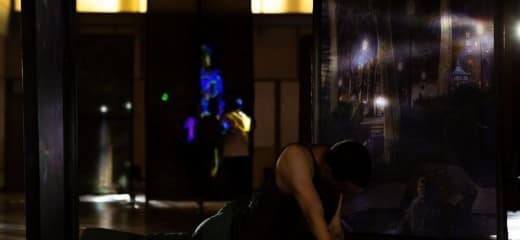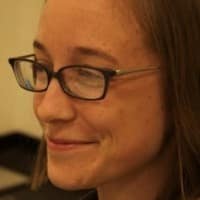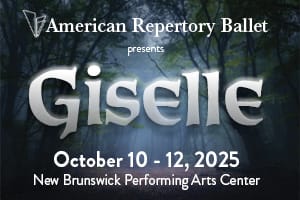“I was always envious of the composers I met because they had time, actual time. I didn’t have actual time; somebody could glance and run.” Visual artist John Dowell found a way around this issue on Thursday night at the Barnes Foundation. He crafted an environment with photographs of Rittenhouse Square at night at the center, completed by three dancers choreographed by Zane Booker, a sound score/composition by Maya Miro Johnson, and a sold-out audience of roughly 200 people arranged around the four sides of the atrium. By framing A Public Intimate Space as a performance piece, Dowell was able to have 90 minutes of ‘actual time’ and focused attention from those present.
A Public Intimate Space only took place on one night, but Dowell’s work is also currently featured in an exhibit, Paths to Freedom, at the Arthur Ross Gallery at the University of Pennsylvania. The exhibit features 26 photographs of Southern cotton fields at night. Like A Public Intimate Space, the images evoke ancestors and spirits, flight and freedom.
A collection of Dowell’s works from the early ‘70s, on view at the African American Museum in Philadelphia until February 19, 2023, are highly recommended for any dance lover. The works in the exhibit vibrate off the walls with kinetic energy, giving the impression of dance scores from a notation system of his own brilliant invention, and reflecting his lifelong interest in dance, music, and time.
At the Barnes, we gathered in the atrium in semi-darkness, allowed to prowl the space for a few minutes as Johnson’s score evoked an orchestra tuning up, gathering energy. Eight large screens with the Rittenhouse photos were clustered in the center. Dowell opened the performance, walking onto the stage area with a cane and dapper black hat, looking back every few seconds as if he had heard something, halting and then advancing. He must have made an exit, but I never saw him leave the stage.
When we spoke before the performance and in the public discussion after the event, Dowell said that he was interested in making people “aware of what you can’t see, the spirit thing.” He wanted to offer people “a ticket to explore themselves. What do they think a spirit would look like?”
I felt most attuned to the possibility of spirits in the space when the dancers moved freely: Arabia Richardson triumphantly striding through the center line carrying billowing white fabric; Caylah Tater gloriously skipping with big, long strides, and limbs extending for miles; Canyon Carroll flicking the long tails of his steampunk magician costume.
I was pulled out of those moments when the dancers doubled as stage crew, manipulating the set pieces for reasons that were unclear to this viewer. Richardson and Tater scooting across the floor while dragging screens with their feet seemed an odd use of dancers capable of such extraordinary movement range. But the overall environment was one of a dreamy, dark cathedral, an inviting space for all kinds of souls.
The Barnes staff members who created the lighting and sound in the difficult, cavernous atrium space deserve an award. The lighting in particular threaded a needle of making the piece satisfyingly dark, but all elements still perceptible to the audience, and in a space without a lighting grid to boot. It could so easily have been too dark to actually see anything or too light, breaking the atmosphere. I would have loved a printed program crediting these problem-solvers, and would have settled for a QR code. Alas, nothing to mark the occasion.
Dowell told me that, “Rittenhouse Square is a Philadelphia gem.” But during the performance, I didn’t find myself thinking about Rittenhouse Square very often. Instead I thought about the Barnes, and how glad I was that they are branching into performance and able to bring so many people to see dancers in the dark. I thought about University of the Arts, where all three dancers were trained, and the Curtis Institute, where the project’s wildly talented composer Maya Miro Johnson is still a student—the way Philadelphia can be a home for young artists.
But mostly I thought about Dowell himself, 81 years old and radiating joy and charm. I thought about what it meant for him to take these photographs at night, his long life in Philadelphia, his ancestors whispering in his ear. John Dowell himself is a Philadelphia gem, and I was glad to see him front and center, entering the performance space and never quite leaving it.
A Public Intimate Space, John Dowell, Jr. with Zane Booker and Maya Miro Johnson, Barnes Foundation, Dec. 8.






